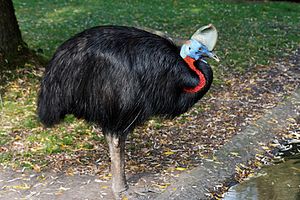Single-lobed cassowary
| Single-lobed cassowary | ||||||||||||
|---|---|---|---|---|---|---|---|---|---|---|---|---|

Cassowary ( Casuarius unappendiculatus ) |
||||||||||||
| Systematics | ||||||||||||
|
||||||||||||
| Scientific name | ||||||||||||
| Casuarius unappendiculatus | ||||||||||||
| ( Blyth , 1860) |
The northern cassowary ( Casuarius unappendiculatus ), also Rothalskasuar or Goldhalskasuar is a large flightless bird art from the family of Casuariidae .
features
A fully grown single-lobed cassowary reaches a back height of 100 cm, a total height of 1.50 to 1.80 m and a weight of 55 to 85 kg. This makes it one of the largest and heaviest living birds of all. Like all ratites, it is incapable of flight. The plumage is black and consists of hard, stiff feathers. The skin on his face is blue and his head has a helmet-like structure made of horn fabric. The neck is bright red to bright yellow in color. There is one flap of skin in the middle of the neck and two at the base of the beak. The legs are long with strong feet. There are three long strong toes on each foot, the middle one being up to 10 cm long, carrying a dagger-shaped claw and representing a dangerous weapon of defense. The sexes are very similar, but the male is usually smaller than the female.
distribution and habitat
Single-lobe cassowaries occur in the northern lowlands of Papua New Guinea and Irian Jayas . The river and coastal rainforests with dense undergrowth serve as habitat.
Diet and Lifestyle
Cassowaries feed mainly on fruits , mushrooms , insects , small mammals, small birds and eggs . Except in the breeding season they live individually and are very territorial. If the birds are cornered, they can give out powerful kicks which, because of the long, dagger-like, inner claws, can also be life-threatening for a person.
Reproduction
Cassowaries prefer to breed in the dry season from June to October. The male builds the nest , a shallow depression in the ground that is lined with grass and leaves and well camouflaged. It only mates with a single female, which then lays three to eight large, bright green-blue eggs in the nest. The eggs measure approximately 9 × 14 cm. The female then moves on and can still mate with other males. The male incubates the eggs for about two months and then takes care of the brown-striped chicks for another nine months. These are refugees .
Danger
The single-lobed cassowary is an endangered species. Research into these very shy animals is very difficult, as there is only a small population.
attitude
In Germany, the red-necked cassowary is kept in the Walsrode World Bird Park .
literature
- Josep del Hoyo (et al.): Handbook of the Birds of the World. Vol. 1. Ostrich to Ducks. Lynx Edicions, Barcelona 1992, ISBN 84-87334-10-5
- Morten Strange: A Photographic Guide to the Birds of Indonesia. Princeton University Press, 2003, ISBN 978-0-691-11495-8
Web links
- Videos, photos and sound recordings on Casuarius unappendiculatus in the Internet Bird Collection
- Entry at birdlife.org
- Casuarius unappendiculatus in the Red List of Threatened Species of the IUCN 2013.2. Listed by: BirdLife International, 2012. Retrieved February 6, 2014.



